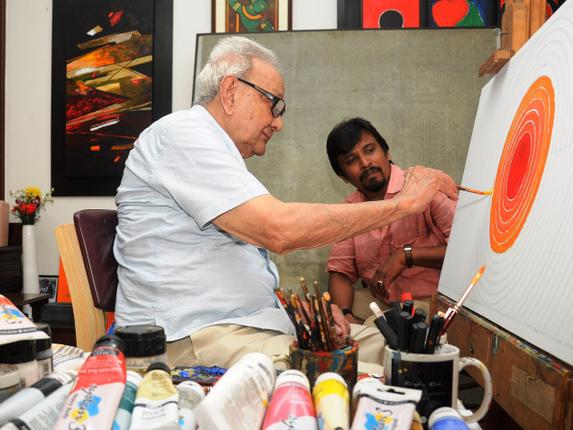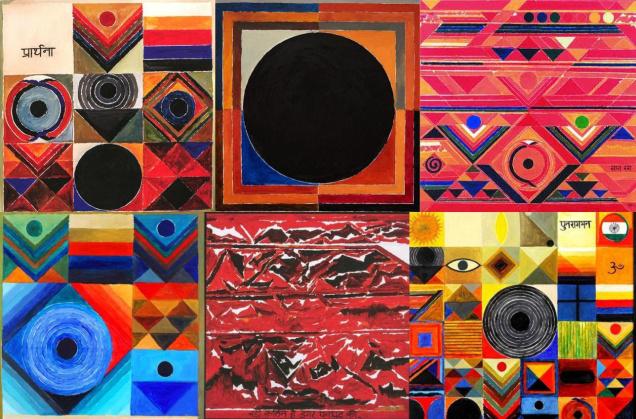
/ The Hindu
“Bindu is a source of energy, source of life. Life begins here, attains infinity here”.
A few years ago, aged 89, S.H. Raza was game to talk to children almost like one, maybe just a couple of years older. Then, at the Jaipur Literature Festival he allowed the youngsters, who had surrounded him, a little peek into his life. Back in India after spending 60 years in France, his life seemed to have come a full circle. Not ready to confer retrospective dignity to his early years, Raza candidly admitted: “I was not fond of school. I was a bad student scoring low marks. Arithmetic did not interest me. My interest lay in drawing and painting. Fortunately, I found the right gurus. It is imperative parents as well as teachers understand a child’s qualities.” Raza himself was lucky. A restless soul that he was, his primary schoolteacher once asked him to continuously look at a dot on the wall inside the classroom to calm his mind. It was a little exercise that was to change the meaning of life for Raza, who turned the simplebindu into a work of art before raising it to the status of life itself.
Incidentally, Raza often judged as a France-based artist, grew up in a Madhya Pradesh village and went on to study at the Sir JJ School of Art. Around the time that the nation was hoisting the tricolour for the first time as an independent country in 1947, he founded the Bombay Progressive Artists’ Group. The group challenged the existing art establishment and Raza’s image as a rebel was probably etched with it.
His long journey in the world of arts started thus. Raza started as a landscape painter, a colourist. Soon the bindu occupied his mind and he turned to metaphysical ideas. This relentless search for the infinite got him plenty of laurels and lots of money. Though he refused to quantify art in terms of money, none could deny the steep price tags that accompanied many of his works. For instance, Saurashtra went for Rs. 15.9 crore. His La Terre attracted a whopping Rs. 18.8 crores.

After linking all the dots in the universe of art, Raza, aged 94, passed away quietly in an intensive care unit of a hospital in New Delhi.
There was not a note that was not dignified, not a colour in the palette that was left unexplored. Often short of breath, hard of hearing with fading vision, Raza with his frail frame looked very much his age to a layman. To a lover of art, he remained a genius, transcending the inevitable frailties of age with determination. Where his eyes failed him, his fingers did not. He continued to whip up magic till the end. Even when the man who was a master at giving a new meaning to colours needed the help of an assistant to mix his colours, his magic did not elude him. Fittingly, one of his last exhibitions was titledNirantar (Relentless). With that single term he lived up to the words of noted Hindi author Ashok Vajpeyi who often said that Raza did not paint to live, he lived to paint. The exhibition itself contained some of the works he had done after coming back to India, between 2011 and 2016.
If in that interaction with youngsters in Jaipur, Raza stated that “Bindu is a source of energy, source of life. Life begins here, attains infinity here”, a few years later in New Delhi he showed other shades to his personality as he talked gently, if, one may say so, almost relentlessly, of Modernism. Yet he did not fail to talk of specifics, happy once again to talk of the bindu, how it provides focus in life, indeed, life itself. Happy he was to talk of early red, the later blues and yellows. And equally at ease talking of the marriage of art and artist, how initially man creates art, how then art forms him. Little wonder, the distinction between Raza and his art gradually disappeared over the years. His art could never conceal the artist, in the final years, it spoke on behalf of the artist. Little wonder, fellow artist Krishen Khanna once said that his friend lived his art! And Raza found profound meaning into something as innocuous as juxtaposing two colours. According to him, the two colours could be in conciliation and harmony or conflict and unending struggle, almost like a man-woman relationship. Raza brought to his canvas the quintessential Indian spirituality and tradition by concentrating his energies on colours, purush-prakriti and nari in his trademark geometric abstract works. And to think, he introduced the French to our artworld and set up studios there!
A contemporary of M.F. Husain, F.N. Souza, Khanna and Tyeb Mehta, Raza carved out his own niche on his own terms. He played with colours like none else and was wise enough to understand that art lovers abroad loved Indian art not jut for its spirituality but its constant soaking in of colours. Of course, like the longest of journeys begins with a single step, for Raza any art too began with a dot. An art work was never the sum of its parts, rather each part, each stage was art itself. Slowly, this centreing of the universe around the dot consumed the mind, and life, itself of Raza. What it gave him in return was priceless art that seeks to confer immortality on the artist.
As he celebrated the bindu in conversations, he occasionally recalled the primary school teacher too. As the Padma Vibhushan awardee fought one last battle one cannot help recall Ashok Vajpeyi’s words that Raza lived to paint. And when he could no longer paint, life lost its meaning… Life indeed had come a full circle. Yes, the bindu is the most important thing of all.
source: http://www.thehindu.com / The Hindu / Home> Features> Friday Review> Art / by Ziya Us Salam / July 23rd, 2016








